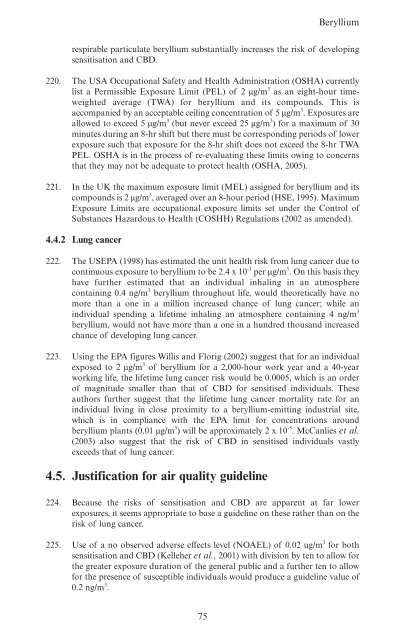Guidelines for Metals and Metalloids in Ambient ... - ARCHIVE: Defra
Guidelines for Metals and Metalloids in Ambient ... - ARCHIVE: Defra
Guidelines for Metals and Metalloids in Ambient ... - ARCHIVE: Defra
Create successful ePaper yourself
Turn your PDF publications into a flip-book with our unique Google optimized e-Paper software.
Beryllium<br />
respirable particulate beryllium substantially <strong>in</strong>creases the risk of develop<strong>in</strong>g<br />
sensitisation <strong>and</strong> CBD.<br />
220. The USA Occupational Safety <strong>and</strong> Health Adm<strong>in</strong>istration (OSHA) currently<br />
list a Permissible Exposure Limit (PEL) of 2 µg/m 3 as an eight-hour timeweighted<br />
average (TWA) <strong>for</strong> beryllium <strong>and</strong> its compounds. This is<br />
accompanied by an acceptable ceil<strong>in</strong>g concentration of 5 µg/m 3 . Exposures are<br />
allowed to exceed 5 µg/m 3 (but never exceed 25 µg/m 3 ) <strong>for</strong> a maximum of 30<br />
m<strong>in</strong>utes dur<strong>in</strong>g an 8-hr shift but there must be correspond<strong>in</strong>g periods of lower<br />
exposure such that exposure <strong>for</strong> the 8-hr shift does not exceed the 8-hr TWA<br />
PEL. OSHA is <strong>in</strong> the process of re-evaluat<strong>in</strong>g these limits ow<strong>in</strong>g to concerns<br />
that they may not be adequate to protect health (OSHA, 2005).<br />
221. In the UK the maximum exposure limit (MEL) assigned <strong>for</strong> beryllium <strong>and</strong> its<br />
compounds is 2 µg/m 3 , averaged over an 8-hour period (HSE, 1995). Maximum<br />
Exposure Limits are occupational exposure limits set under the Control of<br />
Substances Hazardous to Health (COSHH) Regulations (2002 as amended).<br />
4.4.2 Lung cancer<br />
222. The USEPA (1998) has estimated the unit health risk from lung cancer due to<br />
cont<strong>in</strong>uous exposure to beryllium to be 2.4 x 10 -3 per µg/m 3 . On this basis they<br />
have further estimated that an <strong>in</strong>dividual <strong>in</strong>hal<strong>in</strong>g <strong>in</strong> an atmosphere<br />
conta<strong>in</strong><strong>in</strong>g 0.4 ng/m 3 beryllium throughout life, would theoretically have no<br />
more than a one <strong>in</strong> a million <strong>in</strong>creased chance of lung cancer; while an<br />
<strong>in</strong>dividual spend<strong>in</strong>g a lifetime <strong>in</strong>hal<strong>in</strong>g an atmosphere conta<strong>in</strong><strong>in</strong>g 4 ng/m 3<br />
beryllium, would not have more than a one <strong>in</strong> a hundred thous<strong>and</strong> <strong>in</strong>creased<br />
chance of develop<strong>in</strong>g lung cancer.<br />
223. Us<strong>in</strong>g the EPA figures Willis <strong>and</strong> Florig (2002) suggest that <strong>for</strong> an <strong>in</strong>dividual<br />
exposed to 2 µg/m 3 of beryllium <strong>for</strong> a 2,000-hour work year <strong>and</strong> a 40-year<br />
work<strong>in</strong>g life, the lifetime lung cancer risk would be 0.0005, which is an order<br />
of magnitude smaller than that of CBD <strong>for</strong> sensitised <strong>in</strong>dividuals. These<br />
authors further suggest that the lifetime lung cancer mortality rate <strong>for</strong> an<br />
<strong>in</strong>dividual liv<strong>in</strong>g <strong>in</strong> close proximity to a beryllium-emitt<strong>in</strong>g <strong>in</strong>dustrial site,<br />
which is <strong>in</strong> compliance with the EPA limit <strong>for</strong> concentrations around<br />
beryllium plants (0.01 µg/m 3 ) will be approximately 2 x 10 -5 . McCanlies et al.<br />
(2003) also suggest that the risk of CBD <strong>in</strong> sensitised <strong>in</strong>dividuals vastly<br />
exceeds that of lung cancer.<br />
4.5. Justification <strong>for</strong> air quality guidel<strong>in</strong>e<br />
224. Because the risks of sensitisation <strong>and</strong> CBD are apparent at far lower<br />
exposures, it seems appropriate to base a guidel<strong>in</strong>e on these rather than on the<br />
risk of lung cancer.<br />
225. Use of a no observed adverse effects level (NOAEL) of 0.02 ug/m 3 <strong>for</strong> both<br />
sensitisation <strong>and</strong> CBD (Kelleher et al., 2001) with division by ten to allow <strong>for</strong><br />
the greater exposure duration of the general public <strong>and</strong> a further ten to allow<br />
<strong>for</strong> the presence of susceptible <strong>in</strong>dividuals would produce a guidel<strong>in</strong>e value of<br />
0.2 ng/m 3 .<br />
75
















